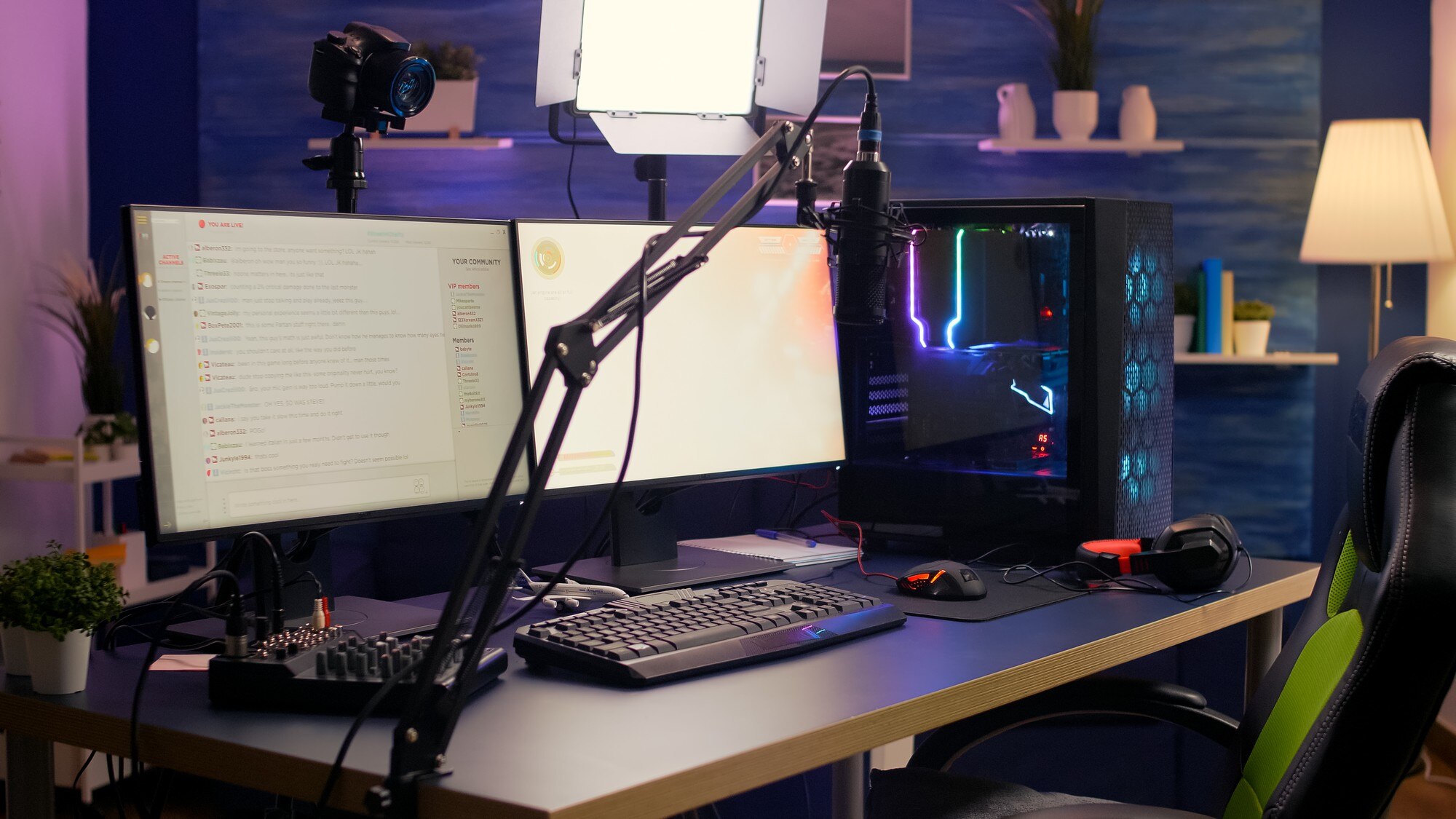Streamers
Setting Up Audio and Video: What Content Creators Need to Know
7 mins read

Equipment is of utmost importance when it comes to streaming. Every single piece of hardware that you use contributes to your experience and the experience of your audience. Aside from your PC set-up, you also need to know what equipment to invest on and how they contribute to your streams. This may all be intimidating to new streamers, so here’s a simple summary of what hardware you can invest on and how they will help you in the long run.
Audio Equipment
There are several pieces of hardware that contribute to the auditory experience in your streams:
- Microphone: Your microphone quality determines how well you’ll be able to communicate within your stream. A faulty mic could mean your audience won’t be able to understand you as much and could hurt your engagement. Of course, there’s nothing wrong with starting out using a basic microphone, but if you have the budget, it’s worth investing into mics that do better jobs isolating your voice from ambient sounds.
- Condenser mics are usually good for general streaming purposes but they are extremely sensitive to sound. That is why one important thing to look at would be the directions (polar patterns) at which it captures sounds–omnidirectional condenser mics capture sound from all sides so this would be best for those who have a relatively quiet streaming area and set up. Cardioid mics, on the other hand, are unidirectional and is good for capturing sounds that are in front of the microphone. This would be best for those who have a busier streaming area, or those with sound-producing gear such as mechanical keyboards with loud switch profiles. The least used for streaming, bi-directional, captures sound from the front and back of the mic which produces a rather unique sound quality.
- Dynamic mics typically have a cardioid polar pattern which makes it ideal for streamers. Streamers get a professional radio-quality vocal sound when using dynamic mics, and it captures a lot less background noise. This is perfect for those who do not have a more quiet streaming area or those who do live performances such as singers with their bands.
- Shotgun mics on the other hand have a narrow directional sound pickup and can record rather accurately even from a distance. This is why they are commonly used for video productions involving a lot of dialogue. For streaming, these are ideally used for conversational streams such as live podcasts.
- ASMR mics are small-diaphragm condenser mics which are great at picking up high frequency ASMR triggers such as blowing, whispering, scratching, tapping, and the like as these capture high frequency sounds with extreme detail. These usually have more than one capsule which captures sound–some even have a specific capsule for the left and the right side, and others even have four to capture a 360 sound.
- Headset: This is a good option for those who are just starting out and who do not wish to invest yet in separate gears for mic and headphones. Needless to say, there are professional streaming headsets available in the market which already capture sounds with a comparatively good quality.
- Sound card: A sound card is the bridge that connects your microphone and headset to your streaming device. This is especially useful if you’re streaming via mobile phone, since some PCs have built-in soundcards within them. Some sound cards have built-in sound boards that let you record and produce sound effects to enhance your streams, as well as equalizers and voice changers.
Lighting Equipment
Let’s face it: your room’s light (and even including the light from your monitor) may not be enough to properly illuminate you on stream. This is why it’s important to invest in proper lighting equipment so that you’ll be seen better as the video starts. In fact, you don’t need to invest in expensive webcams or professional cameras immediately for as long as you have good lighting. Apart from your viewers seeing you (and your background, too, if you like) clearly, good lighting also lessens the grainy video quality which generally occurs in poorly lit set ups.
Natural light from the sun definitely gives a nice illumination to your face but this can definitely cast a lot of shadows which might not be ideal for some and apart from that, this is highly dependent on weather conditions which makes it a little difficult most especially for those living in tropical climates. Others, on the other hand, prefer to stream at night time which is why it can be wiser to make use of artificial lighting equipment instead.
The most basic artificial lighting equipment are ring lights. These can be placed in front of you to properly illuminate your face during streams. Another piece of lighting equipment you can use are colored LED lights and neon lights, placed in the background to enhance your stream design. You can use color-changing lights to add some flair to your streams, especially if you’re not using green screens and you have a nice background you want to show off.
As you delve deeper into streaming, you can study different lighting points such as 3-point lighting which can help give off a professional look to your streams as it helps add more dimension to your video.
Camera and Its Settings
Good camera quality means your audience will see you clearer. The last thing you would want is for you to appear blurred during a livestream and strain your audience’s eyes. Some cameras have an auto-focus function that blurs your background and prioritizes maintaining your clarity if you’re centered in the view but this might not be ideal if you’re the type to move around a lot. It’s usually better to have a set focus point as this makes it a lot less distracting for your viewers.
Aside from that, if you’re using an external camera such as an HD webcam or prosumer mirrorless or full-frame cameras, you also need to learn about other settings such as the exposure triangle (ISO, aperture, and shutter speed) and the resolution that your camera captures visual information but bear in mind that there is no standard setting for all streamers as it highly depends on your lighting condition.
- ISO: This measures the sensitivity of your camera’s sensor to light. A higher ISO value makes the sensor more sensitive to light, allowing you to shoot in darker conditions but can introduce more digital noise or graininess to the image. This means that if you have adequate lighting, you can shoot with a lower ISO sensitivity.
- Shutter speed: Shutter speed refers to the amount of time the camera’s shutter remains open to allow light to hit the sensor. A fast shutter speed freezes motion but lets in less light which can make the video appear darker, while a slow shutter speed captures more light and can create motion blur. A good way to picture this is the rate at which you blink your eyes–the faster you blink, the faster you are able to take a ‘picture’ of what you see but the downside is that you take in less visual information. On the other hand, the slower you blink (or if you keep your eyes open for a longer period of time), you are able to capture more visual information but too slow of a shutter speed can make things blurry.
- Aperture: Aperture is the size of the lens opening, measured in f-stops. A wider aperture (lower f-stop) allows more light and produces a shallower depth of field, creating a blurred background. A narrower aperture (higher f-stop) lets in less light but increases the depth of field, keeping more of the image in focus.
Game Capture Cards
A capture card, as the name suggests, allows you to record footage from your games/videos and show them on stream. You can use capture cards to translate your display from a console to your PC. A good capture card is also a worthy investment, since it means you can easily and seamlessly stream your console games and show off your gaming prowess live. You’ll also be able to record your commentary within the capture card for later uploading.
Green Screen
A green screen allows you to create custom backgrounds for your streams and videos. During livestreams, you can superimpose yourself within your game display so that your background won’t be blocking the view as you play. When using green screens, note that you have to set the correct chroma key in your broadcasting software, and also have adequate lighting so there won’t be unwanted patches of green on your video. In addition, green screen allows you to create a nice background virtually for you to use during streams, so that you don’t have to re-arrange your room just for your content.
There you have it! Those are some of the equipment that you need to know and possibly invest on to make your streams better. As you plan out your stream content, check which of these you’ll need and don’t be in a rush to have the complete set. You’ll get there eventually with hard work and love from your supporters.
